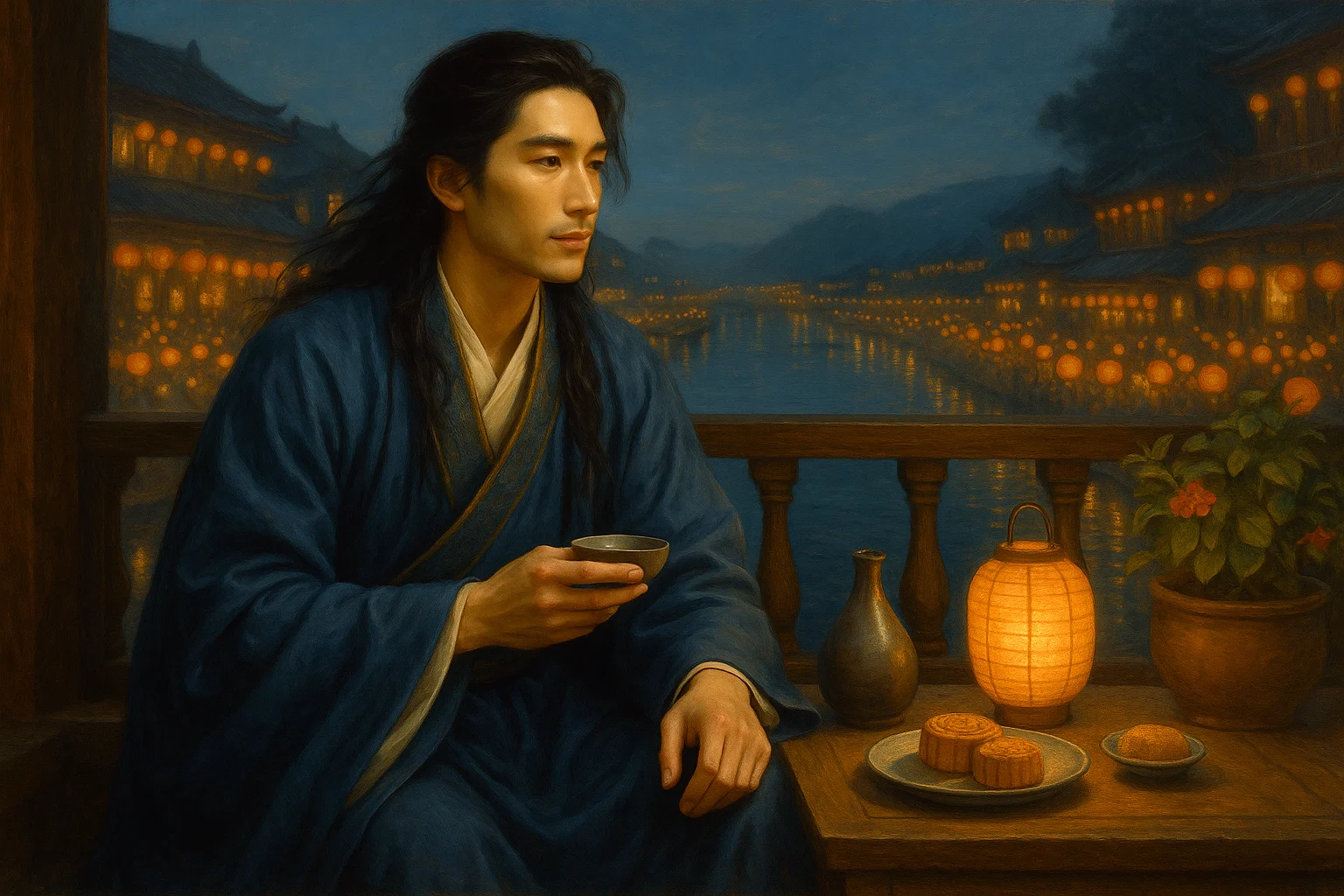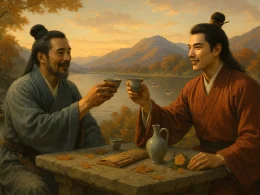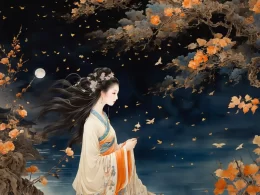Stream's womb sheds first snow-blood,
River-plums menstruate pink buds.
Their petals—uterine jade,
Dare ovulate spring's first trade.
Last night's village moon-egg,
I chart their ovulation hour.
Cliff's cervix juts—
Shadow-sperm swims,
Scent-ovum implants in sleeves.
I libate these fertile blooms,
Cross-examine southern wind's midwives.
Shouyang's cosmetic pageant—
Never matches this water-mirror's
Lean ovulation.
Wind inseminates, rain lactates,
Fit for crowning riotous parturitions.
But Qiang-flute's sterile tune—
See—it aborts again.
Original Poem
「玉烛新 · 溪源新腊后」
溪源新腊后。见数朵江梅,剪裁初就。
晕酥砌玉芳英嫩,故把春心轻漏。
前村昨夜,想弄月、黄昏时候。
孤岸峭,疏影横斜,浓香暗沾襟袖。尊前赋与多材,问岭外风光,故人知否。
周邦彦
寿阳谩斗。终不似,照水一枝清瘦。
风娇雨秀。好乱插、繁花盈首。
须信道,羌管无情,看看又奏。
Interpretation
Composed in the wake of winter's end, this ci poem captures early spring's awakening through the prism of plum blossoms—a floral emblem of resilience and purity in Chinese literati tradition. Zhou Bangyan's delicate brushwork constructs a vibrant yet ethereal vernal tableau, where botanical observation merges with cultural aspiration. The plum here transcends mere floral subject, becoming a medium for expressing intellectual refinement and seasonal rejuvenation.
First Stanza: "溪源新腊后。见数朵江梅,剪裁初就。"
Xī yuán xīn là hòu. Jiàn shù duǒ jiāng méi, jiǎn cái chū jiù.
Beyond thawing streams post-winter rites,
a few Jiangnan plums emerge—
as if freshly sculpted.
The opening frames plum blossoms as nature's inaugural spring artwork. "Thawing streams" (溪源新腊) mark temporal transition, while "sculpted" (剪裁) anthropomorphizes nature's craftsmanship, suggesting the blossoms' perfection rivals human artistry. This aestheticization of natural processes reflects the Song literati's worldview—where wilderness and cultivation harmonize.
"晕酥砌玉芳英嫩,故把春心轻漏。"
Yūn sū qì yù fāng yīng nèn, gù bǎ chūn xīn qīng lòu.
Blushed like powdered jade,
tender petals barely contain
spring's whispered secrets.
Zhou deploys synesthetic imagery—"blushed like powdered jade" (晕酥砌玉)—to convey the blossoms' delicate coloration and texture. The personification "barely contain spring's secrets" (春心轻漏) ingeniously inverts conventional floral symbolism: rather than humans projecting emotions onto flowers, the plum itself becomes spring's confidant, guarding seasonal mysteries.
"前村昨夜,想弄月、黄昏时候。孤岸峭,疏影横斜,浓香暗沾襟袖。"
Qián cūn zuó yè, xiǎng nòng yuè, huáng hūn shí hòu. Gū àn qiào, shū yǐng héng xié, nóng xiāng àn zhān jīn xiù.
Last night in moonlit villages,
at dusk they flirted with radiance—
now on lonely cliffs,
slanting shadows cast,
their perfume clings unseen to sleeves.
This quatrain constructs a nocturnal plumscape. The personified blossoms "flirted with moonlight" (弄月) evokes Li Bai's famous moon-plum interplay, while "slanting shadows" (疏影横斜) directly quotes Lin Bu's classic plum description. The olfactory punchline—"perfume clings unseen" (浓香暗沾)—demonstrates Zhou's genius for implying emotional resonance through sensory detail.
Second Stanza: "尊前赋与多材,问岭外风光,故人知否。"
Zūn qián fù yǔ duō cái, wèn lǐng wài fēng guāng, gù rén zhī fǒu.
Winecup in hand, we versify talents,
inquiring of southern landscapes—
do old friends still know them?
The stanza pivots to literati conviviality. The "versifying talents" (赋与多材) scene epitomizes Song scholarly culture, where poetry competitions accompanied wine gatherings. The rhetorical question about "southern landscapes" (岭外风光) subtly contrasts northern bureaucratic life with southern aesthetic freedom, a tension central to Zhou's experience.
"寿阳谩斗。终不似,照水一枝清瘦。"
Shòu yáng mán dòu. Zhōng bù sì, zhào shuǐ yī zhī qīng shòu.
Shouyang's ornate debates
never rival
one slender branch mirrored in water.
Here Zhou critiques contemporary poetic rivalries ("Shouyang debates" 寿阳谩斗 refers to stylistic disputes) through botanical metaphor. The "slender mirrored branch" (照水一枝清瘦) becomes an aesthetic manifesto—advocating natural elegance over artificial ornamentation, a core tenet of Zhou's artistic philosophy.
"风娇雨秀。好乱插、繁花盈首。须信道,羌管无情,看看又奏。"
Fēng jiāo yǔ xiù. Hǎo luàn chā, fán huā yíng shǒu. Xū xìn dào, qiāng guǎn wú qíng, kàn kàn yòu zòu.
Winds caress, rains adorn—
let blossoms riot in hair!
Know this: though Qiang flutes sound indifferent,
their song persists anew.
The finale erupts in springtime exuberance. "Blossoms riot in hair" (繁花盈首) mirrors Tang dynasty flower-wearing customs, celebrating seasonal abundance. The "Qiang flutes" (羌管)—nomadic instruments symbolizing life's transience—paradoxically continue playing despite their "indifference," suggesting art's endurance beyond human concerns.
Holistic Appreciation
Zhou constructs a diptych of natural observation and cultural reflection. The first stanza's botanical precision (petal texture, moonlight interaction, fragrance diffusion) gives way to the second's intellectual discourse (poetic debates, southern nostalgia, musical metaphors). This progression mirrors the Confucian ideal of "investigating things to extend knowledge" (格物致知)—where close nature study informs humanistic understanding.
The poem's brilliance lies in its dual calibration: microscopically attentive to plum blossoms' materiality ("powdered jade" petals, "clinging" scent) while telescoping to cosmic perspectives (seasons cycling, music's eternity). Zhou positions the plum as nexus between these scales—a single blossom containing spring's essence and art's timelessness.
Artistic Merits
- Scenery and Emotion Intertwined, Poetic and Philosophical
Rather than merely describing landscapes, the poem reflects inner emotions through nature, portraying the interaction between humanity and the natural world. This imbues the poetic realm with lyrical and philosophical depth, exemplifying Zhou Bangyan’s signature style of "scenery and sentiment in perfect harmony." - Exquisite Scenery, Rich Sensory Imagery
The depiction of riverside plum blossoms is meticulously crafted, capturing their color, texture, and fragrance with vivid detail, creating a strong visual and olfactory experience. Phrases like "blushed like powdered jade" (晕酥砌玉) and "their perfume clings unseen to sleeves" (浓香暗沾襟袖) are both vivid and evocative, immersing readers in the serene beauty of spring. - Clear Structural Layers, Balanced Rhythm
The first stanza expresses joy and tenderness toward spring through natural imagery, while the second shifts to humanistic scenes, reflecting the poet’s engagement with literary culture and intellectual identity. Though differing in theme, the two sections resonate with each other, achieving a perfect fusion of nature and culture, emotion and intellect. - Elegant Subtlety, Rich Symbolism
Zhou Bangyan masterfully employs allusions and symbolism—such as "sculpted" (剪裁) hinting at cultivated beauty, "Shouyang debates" (寿阳谩斗) alluding to contemporary poetic rivalries, and the plum blossom symbolizing noble character. These classical references deepen the poem’s meaning while maintaining a refined and unpretentious tone. - Restrained Yet Profound Emotion
Though not overtly expressive, the emotions in the poem unfold gradually, subtly conveying a love for spring, an appreciation for talent, and a calm acceptance of life’s changes. The natural flow of sentiment, sincere yet understated, embodies the Song lyric tradition’s emphasis on "winning through artistic conception." - Concise Language with Musical Beauty
The verses flow smoothly, with natural rhymes and a lively, varied rhythm. Lines like "Know this: though Qiang flutes sound indifferent, / their song persists anew" (须信道,羌管无情,看看又奏) are concise yet rich in layered emotion, showcasing Zhou’s command of language and melodic grace.
Insights
Zhou's poem reveals how premodern intellectuals naturalized culture. The plum blossom isn't merely admired—it becomes ethical instructor ("slender branch" versus ornate debates), temporal marker (harbinger of spring), and aesthetic paradigm (natural elegance over artifice).
For modern readers, the work models ecological mindfulness—the "clinging perfume" and "mirrored branch" remind us that true observation engages all senses and acknowledges nature's agency. The poem's ultimate lesson is that profundity resides not in grand statements but in attentive particulars: a single blossom's tilt, an unnoticed fragrance, a flute's distant echo.
By celebrating the plum's "slenderness" (清瘦) as aesthetic ideal, Zhou champions a countercultural minimalism relevant today—an antidote to our era of excess, where true value often lies in the unadorned and essential. The poem thus becomes not just seasonal celebration but timeless aesthetic manifesto.
About the Poet

Zhou Bangyan (周邦彦 1056 - 1121), a native of Qiantang (modern Hangzhou, Zhejiang), was the culminating master of the wanyue (graceful and restrained) ci poetry of the Northern Song Dynasty. A virtuoso in musical temperament, his ci are renowned for their opulent refinement and technical perfection. He created dozens of new melodic patterns (cipai) and adhered to strict tonal rules, earning him the title "Crown of Ci Poets." His influence extended to Southern Song masters like Jiang Kui and Wu Wenying, establishing him as the founding patriarch of the Rhymed Ci School.












